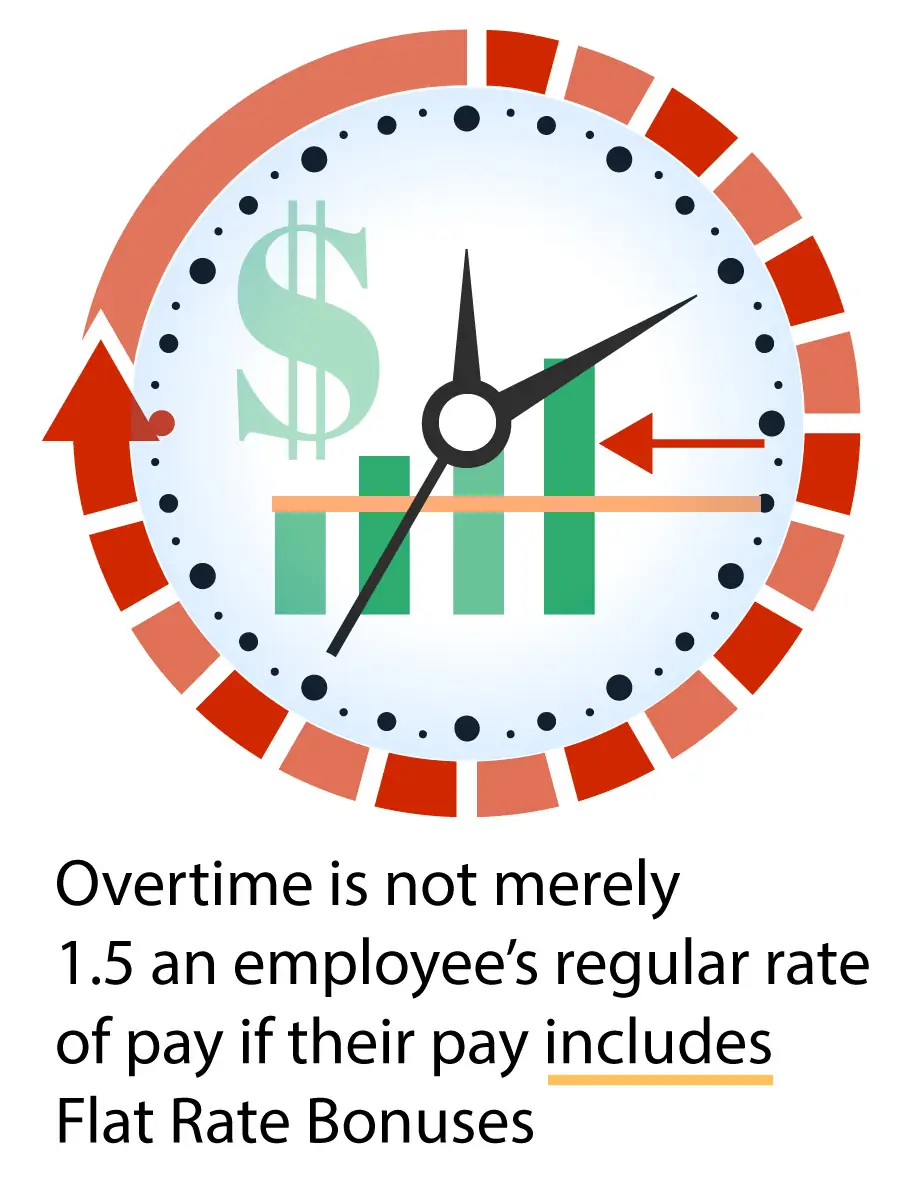Bonus Pay must be included in Regular Rate of Pay for Nonexempt Employees
Recently several court cases as well as publications from various state and federal labor agencies have decided regular hourly pay for nonexempt employees has to include not only the agreed to hourly rate but compensation based upon fixed rate bonuses. This means that if a California employee earns $18.00 an hour plus a guaranteed $400.00 a week bonus their regular hourly rate is actually $28.00 an hour. The math on this is $400 divided into 40 = $10.00 an hour. $10.00 an hour plus $18.00 an hour equals $28.00 per hour. Hourly rates of pay for bonuses must be based upon the regular number of hours worked. If an employee works overtime the amount of the bonus pay does not fluctuate.
Call 1-877-525-0700
If you were not paid your full hourly wage
because flat sum bonuses were not figured into your pay
Regular rates of pay based upon bonuses assume the bonus is a guaranteed sum. If it is a discretionary bonus regular rates of pay are not based upon a discretionary bonus. Fluctuating bonuses may entitle the employee to additional pay if the fluctuation is based upon something like different calendar months, but the bonus is guaranteed and not tied to performance the employee may or may not meet. For example, if the guaranteed bonus for January is $40 each 40 hour work week and $400 each work weekend in December because the employer is very busy then and asks employees to work over the holidays these are guaranteed, fixed sum bonuses. A bonus such as $500 more a month if your sales are over $100,000 is not a flat rate bonus. It is a contingent bonus. Although a certain volume of sales may be met every month because it is not that hard to sell one or two units of something, the bonus is nonetheless contingent and does not figure into the regular hourly rate of pay.
If an employee is paid a meal break or rest break premium because they missed their meal or rest break, the hourly pay for each hour of a missed meal or rest break must be based upon the correct hourly rate of pay. If the employee earned flat rate bonuses the hour of pay paid for the meal break or rest break premium pay must include appropriate additions due to the employee’s flat rate bonus pay.
The DIVISION OF LABOR STANDARDS ENFORCEMENT POLICIES AND INTERPRETATIONS MANUAL section 49.2.4.2 states,
“If the bonus is a flat sum, such as $300 for continuing to the end of the season, or $5.00 for each day worked, the regular bonus rate is determined by dividing the bonus by the maximum legal regular hours worked during the period to which the bonus applies. This is so because the bonus is not designed to be an incentive for increased production for each hour of work; but, instead is designed to insure that the employee remain in the employ of the employer. To allow this bonus to be calculated by dividing by the total (instead of the straight time hours) would encourage, rather than discourage, the use of overtime. Thus, a premium based on bonus is required for each overtime hour during the period in order to comply with public policy. This enforcement position was adopted by the California Supreme Court in Alvarado v. Dart Container Corp. (2018) 4 Cal.5th 542.”
The Division of Labor Standards Enforcement makes policies concerning wages and hourly pay in California. Their interpretations are given great deference if a court has not decided a case in a contradictory fashion.

BONUS INCLUDED IN OVERTIME
Flat sum bonuses must be figured into the overtime rate for nonexempt California employees. Nonexempt employees are those who are entitled to overtime. Just because somebody is salaried does not mean they are necessarily exempt (a qualified employee wage and hour lawyer can explain why). The term flat sum bonus includes all guaranteed compensation in addition to one’s normal hourly rate. Besides the California Supreme Court and the California appellate courts, on the Federal level there is a July 1, 2019 opinion letter by the U.S. Department of Labor, referencing another letter, stating, “Nondiscretionary bonuses count as remuneration that an employer must include in the regular rate of pay.” It follows that overtime pay must be based upon the correct hourly rate.
The Employment Lawyers Group succeeded in a court ruling in a class action in which the employer argued the term flat rate bonus must be narrowly construed, and cannot include a fixed and agreed to rate for rent credits. At this point, any nonexempt employee who has not been paid an overtime rate based upon the amount of their fixed rate bonus is entitled to the difference between what they were paid and what they should have been paid making their guaranteed bonus part of their regular and overtime rate.
For overtime purposes, in determining the right rate of overtime pay if a flat rate bonus is due to the employee, the bonus is figured based upon the employee’s non-overtime work week. If an employee only works 30 hours a week the bonus would be based upon a 30 hour work week. If the employee is a normal 40 hour a week employee the bonus is based upon a 40 hour work week. It is not based upon the actual number of hours the employee works in excess of 40 in a week.
SUE FOR FLAT RATE BONUSES NOT INCLUDED IN REGULAR HOURLY WAGE OR OVERTIME RATE
Lawsuits for a failure to properly pay the correct regular rate of pay and overtime rate if the employee is entitled to additional guaranteed compensation beyond their normal hourly rate should be brought. The vigilant prosecution of these lawsuits will insure the employee is properly paid for every regular hour and overtime hour worked at the right rate of pay. Delay in filing these lawsuits may lead to lapsed statutes of limitation. The statute of limitations for penalties under the Private Attorney General Act (PAGA) is only one year. The statute of limitations for suing to recover wages when the rate of pay was paid wrong is up to four years.
Lawsuits for recovery of the right hourly rate, correct overtime rate based upon flat rate bonuses, and the right rate of double time pay are lawsuits that also seek to recover various penalties. Besides penalties interest is due from the time the original wage was due. Attorney fees and costs can also be recovered.
If the damages for being paid the wrong hourly rate or wrong overtime rate are large the case can be brought by one employee. If only a few thousand dollars is at stake, the case needs to be brought as a larger action such as a multi-employee case, a class action, or a PAGA action.
Call 1-877-525-0700
to Start Your Case for Being Paid the Wrong Rate of Pay
if you are one Person or Want to Sue on Behalf of Many People

